IV - Pressure Gradients #
Flow Doesn’t Do Well Under Adversity #
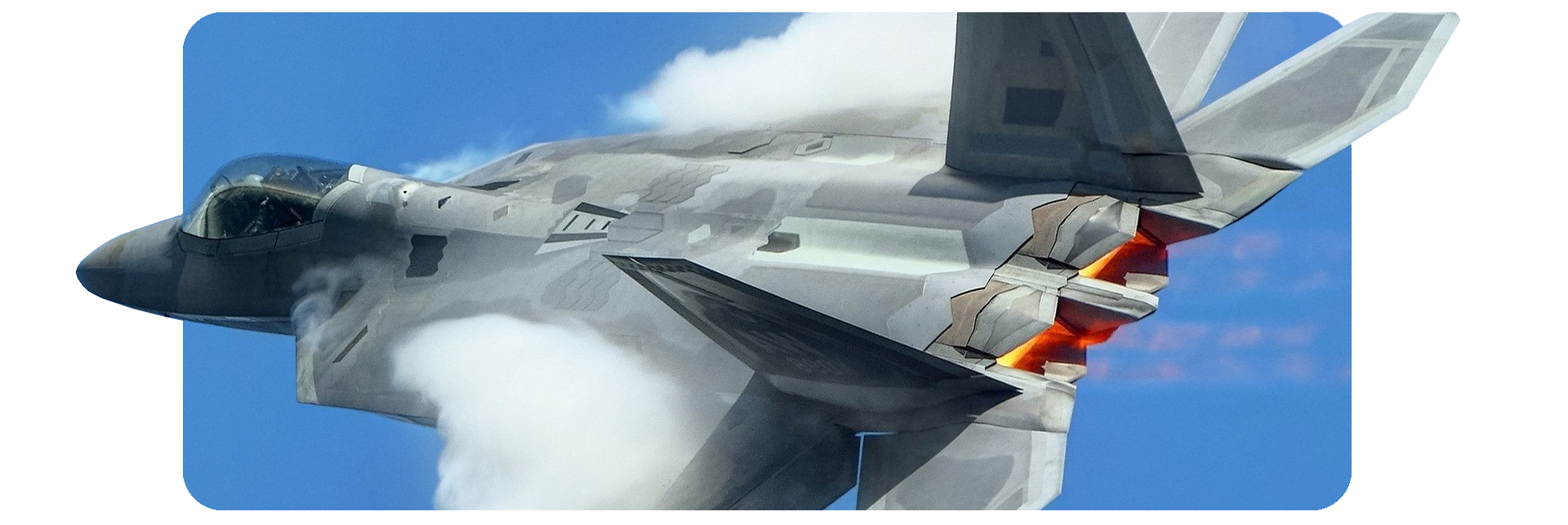
An F-22 Raptor during a high angle of attack maneuver. Image courtesy of OC Air Show.
Introductory Thoughts #
A design that allows the air to navigate around its surface without prematurely separating is ideal. However, this is easier said than done, as physics imposes limitations on what the flow can & can’t tolerate. Vehicles that maximize aerodynamic potential operate at the razors edge, a fine line between remarkable capability and, in certain scenarios, having it literally come crashing down.
Least Resistance #
Most things tend to follow the path of least resistance. For example, a river tends to flow from high to low elevation, from mountains into valleys. This is due to the force of gravity pulling the water along, requiring the flow to expend minimal energy for its motion. Flowing downhill is a favorable condition for the river.

Conversely, rivers don’t flow uphill. Working against gravity slows down a river considerably, and if the gradient of elevation is too steep, it wont flow at all, as it doesn’t have the energy surplus needed to win a long term battle with gravity. Flowing uphill is an adverse condition for the river.

High To Low #
Like a river wants to flow from high to low elevation, air wants to flow from high to low static pressure. However, the shape of the object often times requires the flow to go through a rise in static pressure, forcing the flow to behave opposite to its natural inclination. Its receptiveness to doing this depends on the gradient of static pressure across the geometry.
These gradients come in two flavors:

| Point | Behavior |
|---|---|
| 1. | Favorable - The static pressure decreases along the flow direction, from high to low. |
| 2. | Adverse - The static pressure increases along the flow direction, from low to high. |
In general, as the flow diverges across the body, the static pressure decreases along the flow direction, creating a favorable pressure gradient. The point at which the flow inflects from diverging to converging corresponds to peak low static pressure (and peak high dynamic pressure).
However, the flow needs to eventually depart the surface and meld back into freestream with minimal drama. As an analogy, think of how cars need a highway on-ramp to align with the pace of vehicles already on the highway, as this allows them to smoothly flow in without violent braking or acceleration.
To go from this point (of low static and high dynamic pressure) to freestream smoothly, the flow has to realign its energy distribution with that of freestream (dynamic pressure needs to lower, static pressure needs to rise). This is at odds with its aversion to flowing through an adverse pressure gradients. However, the longer the flow has to realign its features with that of freestream (the longer the proverbial on-ramp), the more gradual the adverse pressure gradient, and the easier it is to persuade the flow to follow this path. The process of flow returning to ambient static pressure is termed pressure recovery.
Pressure Gradients #
These gradients have non-trivial effects on the flow.
In the images below, the black lines represent the momentum of the air at different heights from the surface, and the gray lines represent the effects of the pressure gradient. The relative proportions are exaggerated for sake of visual clarity.
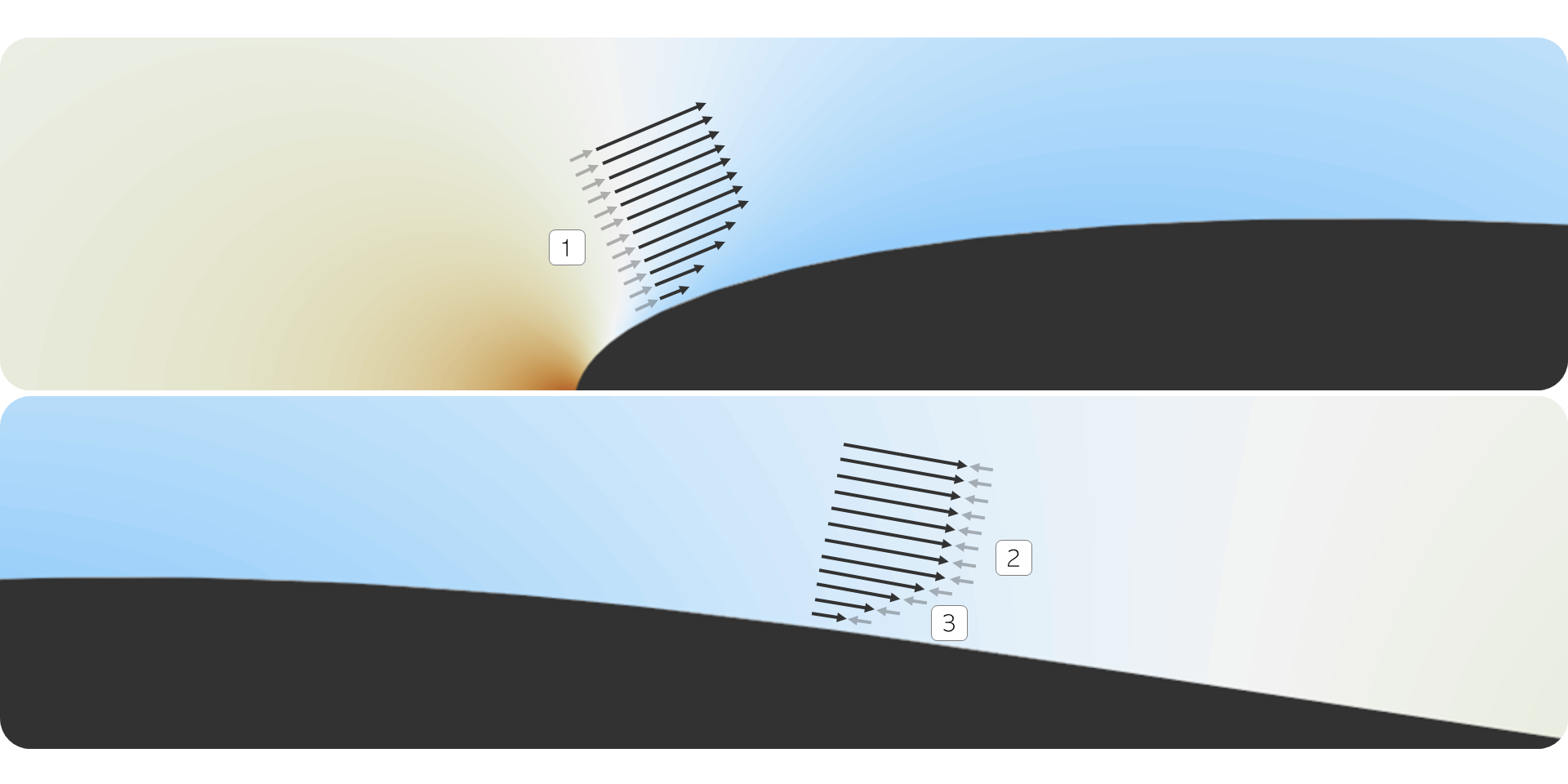
| Point | Behavior |
|---|---|
| 1. | A favorable pressure gradient provides an additional ‘push’ that moves the flow along (like a river flowing downhill). |
| 2. | Conversely, an adverse pressure gradient provides an opposite push that tries to stop the flow (like a river flowing uphill) |
| 3. | For the majority of the flow, the effect of these gradients is negligible because it’s small in proportion to the momentum of the fluid. However, due to the effects of friction, the boundary layer is of significantly lower momentum than the bulk fluid. As a result, it’s more easily effected by these external forces. |
The effect of the pressure gradients on the boundary layer give way to important behavior.
Favorable Gradient #
In the absence of any pressure gradient, the thickness of the boundary layer increases along the body as the effect of friction compounds. However, the forward ‘push’ of a favorable pressure gradient acts to thin the boundary layer, in effect acting to reverse the effects of friction.

The height of the boundary layer is greatly exaggerated in all of the images on this article for sake of visual clarity.
Adverse Gradient #
Because the force produced by an adverse pressure gradient opposes the flow direction, the extra resistance resulting from the adverse pressure gradient strains the boundary layer as it tries to make it’s way up the static pressure ‘hill’. The effect of this extra strain slows down the boundary layer even more. This intensifies the effects of friction, causing the BL to thicken.
In short, the flow has to put in more work to push through the adverse pressure gradient.

Why Does it Matter? #
As a river wont flow up a hill that’s too steep (and will just find a way around), flow won’t follow a path in which the adverse pressure gradient is too steep.
A steep adverse pressure gradient slows down the boundary layer so much that the flow near the surface starts going backwards (flow reversal). Rather than push through the reversal, the rest of the boundary layer takes the path of least resistance and goes around, separating from the surface. Once the boundary layer separates, the outer flow comes along with it.

| Point | Behavior |
|---|---|
| 1. | The adverse pressure gradient causes the boundary layer to rapidly thicken along the surface. |
| 2. | Tight curvature leads to lower static pressure, but if the curvature is near the trailing edge of the body, it leaves the flow with a very limited distance in which to recover its pressure, creating a very steep pressure gradient. When the adverse pressure gradient is too intense, the bottom of the boundary layer reverses, and all of the flow separates from the surface. |
As a rule of thumb, tight curvature towards the rear of the object almost always leads to separation. In contrast, flow within a favorable pressure gradient is resilient and can withstand any amount of curvature.
As a demonstration of this, consider flow around a cylinder, a body that is symmetrical fore and aft. Due to the favorable pressure gradient, the flow navigates the tight curvature of the leading edge without issue.
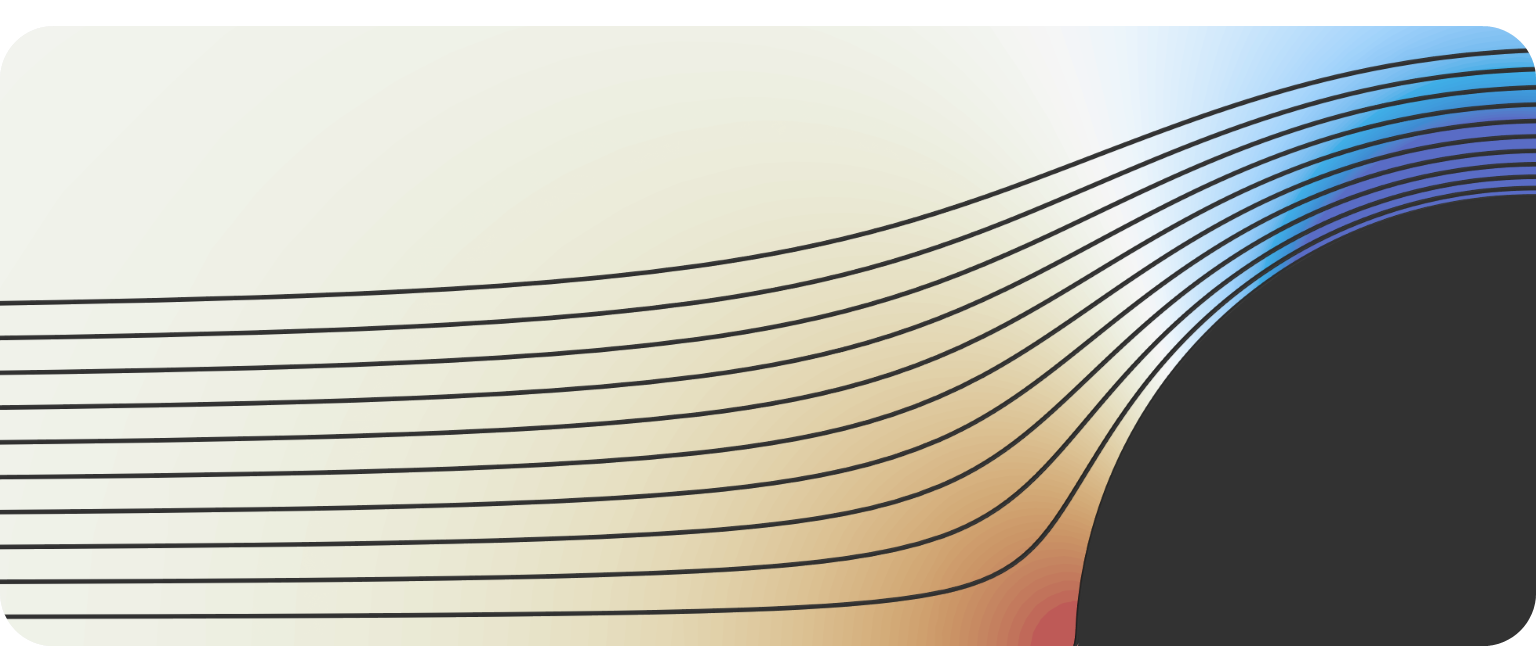
However, when flow reaches the back half, the rapid curvature creates a steep adverse pressure gradient that almost immediately leads to separation (due to flow reversal near the surface).
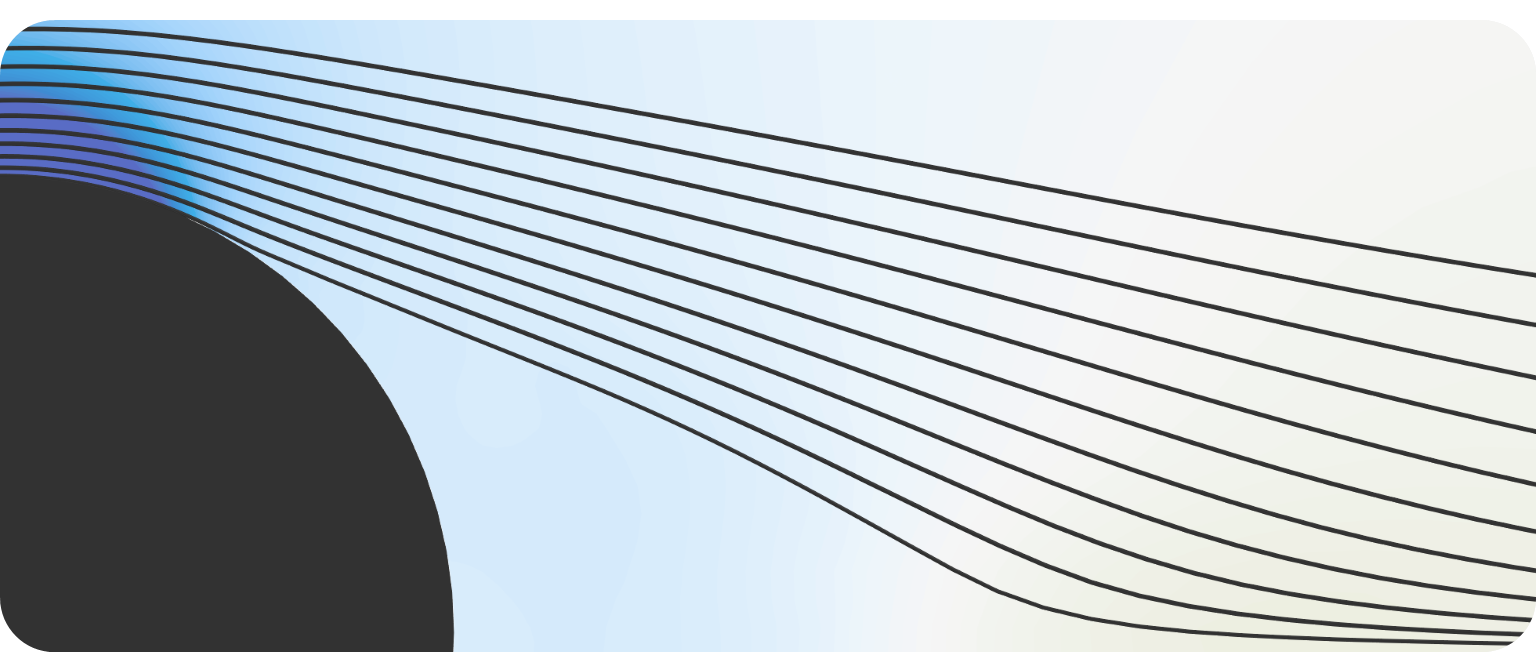
In summary, aerodynamicists can design geometry to take liberties with the flow in favorable pressure gradients, but need to be extremely gentle with the flow after it enters an adverse pressure gradient, for fear of inducing separation.

The general mantra is to get the rapid curvature over with early, and transition smoothly out of it.
Real World Applications #
Consider the streamlined shape again, which resembles the cross-section of an airplane wing very closely. To take to the air, an airplane wing has to produce lift, which requires a net turning of the air downwards. As shown below, the streamlined shape produces no lift as the flow on either side is symmetric.

| Point | Behavior |
|---|---|
| 1. | The flow follows the body without issue, as the adverse pressure gradient in the pressure recovery region is mild. |
However, when the wing has ‘angle of attack’, it creates an asymmetric flowfield that displaces air downwards, producing lift.
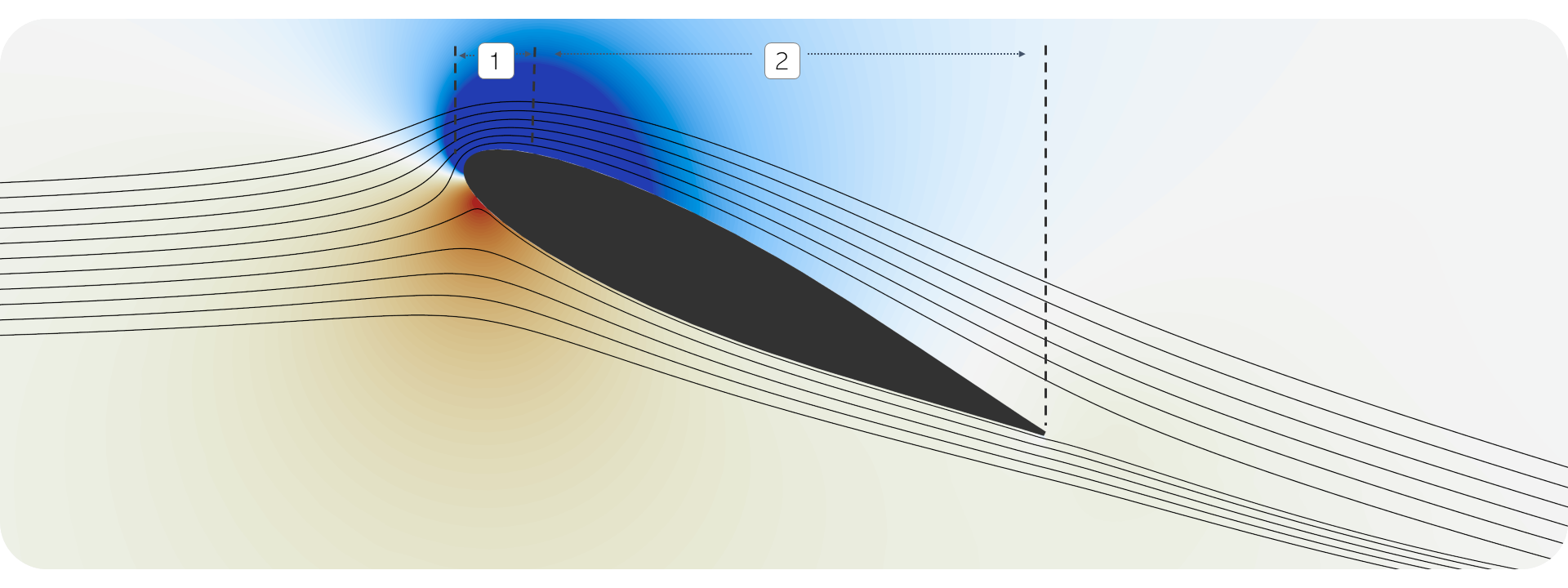
| Point | Behavior |
|---|---|
| 1. | The angle of attack of the wing forces the flow to tightly wrap around its upper surface. The tight convex curvature of the streamlines creates very low static pressure along the upper leading edge. However, because the leading edge is within a favorable pressure gradient, the flow is able to navigate the tight curvature of the leading edge without issue. |
| 2. | The low static pressure requires a stronger pressure recovery, as the flow has to return to ambient static pressure downstream of the body. There is slight separation here, but generally the flow closely follows the contour of the wing because the adverse pressure gradient is not overwhelming. |
However, if too much angle of attack is assumed, it’s a different story altogether.
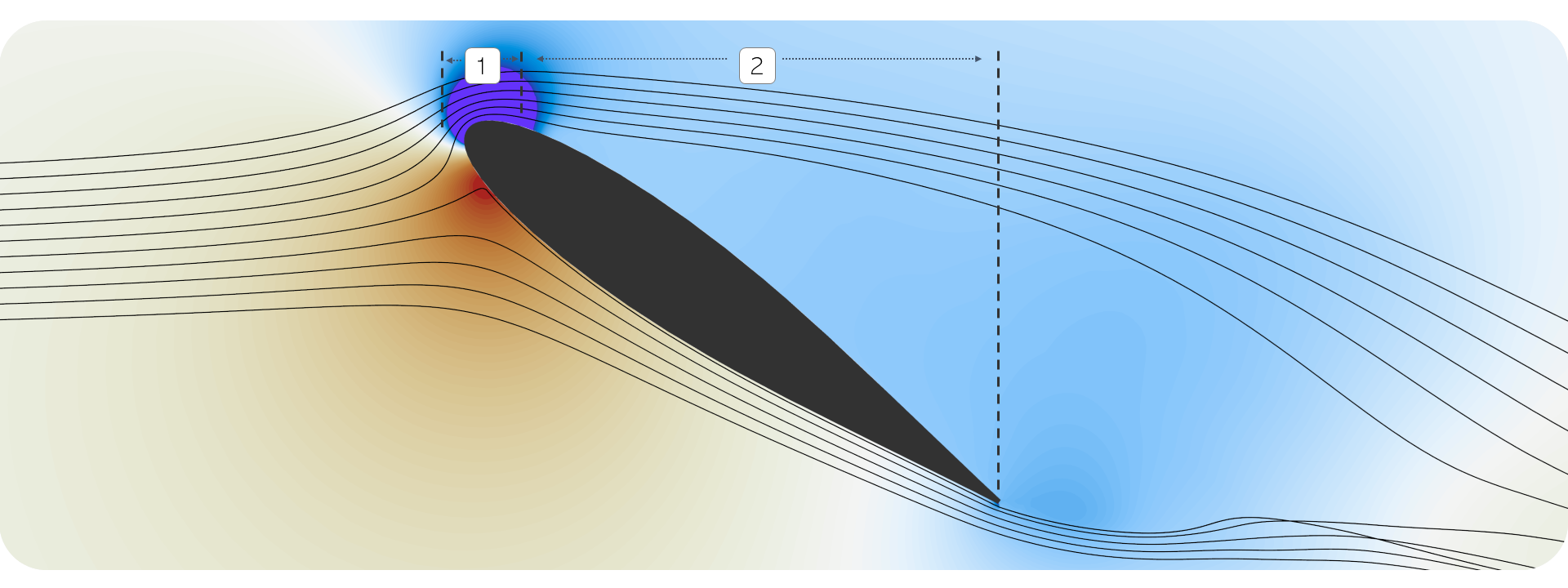
| Point | Behavior |
|---|---|
| 1. | The increased angle of attack creates an even tighter initial wraparound of the flow on the leading edge, resulting in even lower static pressure. |
| 2. | However, this gives way to an even steeper adverse pressure gradient. In this case, it’s so steep that the flow immediately separates upon seeing it. |
If the aircraft assumes an angle of attack that is too high, the flow on the wing separates from the surface, dramatically reducing lift and increasing drag, ultimately causing the airplane to fall out of the sky. This behavior is called stall. Unfortunately, once the flow on the wing separates, its much to get it to reattach, a phenomenon called aerodynamic hysteresis.
Automotive #
I - Form discusses the advancement in the aerodynamics of road cars, using an old BMW 3 Series & Tesla Model 3 as an example. The most visually obvious distinction is in the roof lines, the Tesla equipped with a much larger, continuous radius.

Pressure gradients inform why the Model 3’s roof line is the way it is. The rapid increase in curvature on the trailing edge of the old BMW’s roof creates a steep adverse pressure gradient that causes the flow to separate. To prevent flow separation, the Model 3 distributes the curvature over a larger distance to soften the adverse pressure gradient. This achieves the desired convergence without separation.
Concluding Thoughts #
Designing the geometry to minimize the severity of the adverse pressure gradient is an important design criteria. The perfect design is the one that puts the flow right on the cusp of separating on the surface at all points without going over. This is a difficult endeavor, but pays dividends for performance.
For questions or clarifications on this, or any other article, reach out to Nav@WorksAero.com.